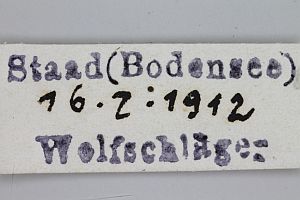

 +12Kontinente:EUAS
+12Kontinente:EUAS2. Diagnose
2.1. Männchen
2.2. Weibchen
2.3. Geschlecht nicht bestimmt
2.4. Erstbeschreibung
3. Weitere Informationen
3.1. Etymologie (Namenserklärung)
Varenne & Nel (2017: 111) schreiben zum Synonym C. paludicolella: « « paludicolella » qui habite dans des zones marécageuses, pour rappeler le biotope de capture des deux femelles connus. »
3.2. Andere Kombinationen
- Sericoris doubledayana Barrett, 1872 [Originalkombination]
3.3. Synonyme
- Celypha paludicolella Varenne & Nel, 2017 [synonymisiert durch Huemer & van Nieukerken (2021)]
3.4. Taxonomie
Huemer & van Nieukerken (2021) überprüften den Holotypus von Celypha paludicolella und stellten fest: "Celypha paludicolella was described from a female holotype and a female paratype and compared with C. rivulana (Scopoli, 1763) and C. lacunana ([Denis & Schiffermüller], 1775) (Varenne & Nel 2017a). However, the DNA barcode sequence of the holotype as well as adult morphology correspond to C. doubledayana (Barrett, 1872), a species known from the same type of habitat, wet meadows and fens. We therefore synonymize C. paludicolella with C. doubledayana."
3.5. Faunistik
Nach Gaedike & Heinicke (1999) in Deutschland nur mit Angaben von vor 1980 aus Baden-Württemberg und aktuell (d.h. nach 1980) aus Nordrhein-Westfalen bekannt. Gaedike et al. (2017) erwähnen Nordrhein-Westfalen gar nicht mehr, führen aber Bayern mit Nachweis nach 2000 an. Von Rudolf Schick (e-Mail am 18. August 2022 an E. Rennwald) erhielten wir das oben gezeigte Lebendfoto vom 17. August 2022 aus dem NSG Eriskircher Ried am Bodensee in Baden-Württemberg, verbunden mit der Erläuterung: "Das Habitat, in dem ich sie regelmäßig finde (abendlicher Kescherfang und Lichtfang), sind Pfeifengraswiesen und das Kalkflachmoor (Molinion caeruleae, Caricion davallianae), die aber im Eriskircher Ried vom Bodenseewasserspiegel beeinflusst sind."
Das Synonym C. paludicolella wurde aus Südfrankreich beschrieben.
(Autor: Erwin Rennwald)
3.6. Typenmaterial
Varenne & Nel (2017: 109) teilen zum Synonym C. paludicolella mit: « HOLOTYPE femelle : France, Savoie, Chindrieux, 230 m, 26 juin 2016, Th. Varenne leg., prép. gen. TV n° 6169, Coll. Th. Varenne à Nice.
PARATYPE : 1 femelle, idem, 18 juin 2015, Th. Varenne leg., prép. gen. TV n° 5754, Coll. Th. Varenne à Nice. »
3.7. Literatur
- Erstbeschreibung: Barrett, C. G. (1872): Description of a new species of Sericoris from Britain. — The Entomologist's Monthly Magazine 8: 246-247. London (John van Voorst).
- Gaedike, R. & W. Heinicke (1999): Verzeichnis der Schmetterlinge Deutschlands (Entomofauna Germanica 3). — Entomologische Nachrichten und Berichte, Beiheft 5: 1-216.
- Huemer, P. & E. van Nieukerken (2021): Identity of some recently described Lepidoptera from France — re-assessed with DNA barcodes and morphology. — Zootaxa 4941 (3): 301–337. [zum open-access-Artikel und PDF-download auf mapress.com]
- Beschreibung als Celypha paludicolella: Varenne, T. & J. Nel (2017): Descriptions de Nemapogon peslieri sp. n. et de Celypha paludicolella sp. n. (Lepidoptera, Tineidae, Tortricidae). — Revue de l'Association Roussillonnaise d'Entomologie 26 (2): 107-111.





















